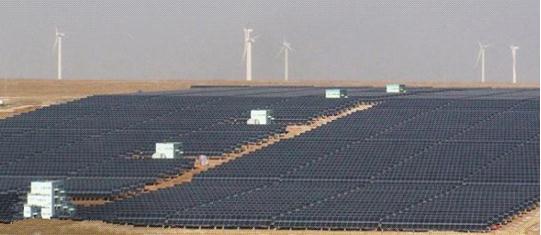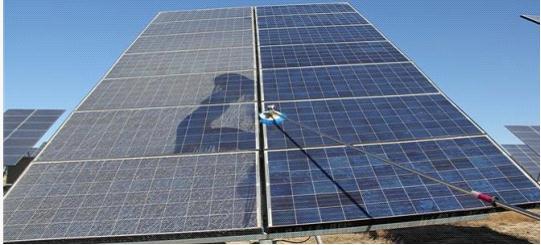China's solar panel cleaning technology fills the gaps in the world
 |
8:00 Tripartite Solar Panel Cleaning Technology Fills the World's Blanket
A few days ago, from the news in Jinan, Shandong, a local company successfully explored a new “three-in-one†cleaning technology for solar panels, filling the world's gaps in the field. The news spread, causing widespread concern from all walks of life.
"This technology is a great news for China's photovoltaic industry, which means that China's solar power plants can recover at least hundreds of millions of losses each year!" A new energy expert highly praised this.
In order to understand its ins and outs, the reporter conducted a special investigation visit.
Awakening loss: The solar power industry is devoured by dust by 250 million yuan a year
What does a grain of dust mean? If anyone says that hundreds of millions of yuan are lost each year, everyone will be surprised! But it is true.
“Because we can't completely solve the problem of panel cleaning, the actual power generation efficiency of the panel is only about 17-18%, and our annual loss is more than 2 million.†In the investigation, the head of a 20MW solar photovoltaic power plant in Shaanxi Yulin was not untroubled.
The power station is designed to generate 20 million kilowatt-hours of electricity per year. According to the government's per-kilowatt subsidy of 1 yuan, the annual revenue can reach more than 20 million yuan. However, in reality, they simply cannot get so much money. The reason for this problem is small. Small dust.

Small dust makes China's solar power industry lose a minimum of 250 million yuan a year
In fact, small dust has always been a fatal problem to reduce the amount of solar panel power generation. Even the exploration of space that represents top technology cannot avoid this problem.
When the US “Opportunity†space probe began its mission of Mars exploration, 1.3 meters of solar panels could provide 900 watt-hours of electricity per day. However, by June 2010, solar panels were exposed to Martian dust, providing daily power. When it fell to 500 to 600 watts, NASA had to try to keep the two rover parked on a south-facing slope so that they could receive more sunlight.
According to the data, in 2012, the growth rate of China's photovoltaic industry reached 100%, and the annual designed power generation capacity reached 2 GW. This also means that in 2012, China’s solar power industry lost as much as 250 million yuan due to dust!
No help at all: High-tech means is weak, traditional methods are ineffective
Faced with huge economic losses, no solar power plant operator can remain indifferent. So far, no cure has been made to solve this problem completely.
According to surveys, the main methods of solar panel cleaning are divided into artificial water washing and industrial cleaning equipment flushing, but new problems brought about by the power plants are even more puzzling.
“The efficiency of artificial water washing is too low. To ensure that all panels are kept clean at all times, we need at least 20 cleaning workers to work uninterrupted, and can the fragile panels help people's weight?†Yulin, the power plant owner Say.
Industrial cleaning equipment can effectively solve this problem?
According to surveys, according to the usual design standards, a minimum of one-time investment of several million yuan is required for every 10 MW power plant supporting industrial cleaning system, which can be described as expensive. At the same time, the large area short circuit caused by the high pressure water gun will cause the power generation efficiency to decrease. What is even more troublesome is that the ice layer produced by the use of high-pressure water guns in winter can seriously weaken the optical effect, especially the solar power plants in the north.
"We can't afford to spend millions on buying a lot of equipment that we can't use for half a year!" said a person in charge of a power plant in the northeast.
In the United States, to address this issue, Seamus Curran, head of physics at the University of Houston's NanoEnergy Institute in 2012, developed a self-cleaning solar panel coating that is said to prevent hazardous contaminants from reaching and does not affect solar energy. The ability of the panels to absorb sunlight, but the market does not "cold", so far this technology is still in the laboratory stage, as a "conceptual" product has been mentioned.
So how did this company in Shandong solve this problem?
New Challenges for Modern Housekeeping Services Companies: Can Solar Panel Cleaning Do
The reporter went to Jinan, Shandong, and found that, surprisingly, the company that explored new types of solar panel cleaning technology was not a high-tech company that people had imagined was unfathomable, nor was it a so-called industry giant but a new one. Modern housekeeping service company - Ji'nan 89 domestic service company.
Founded in 2009, the company is a comprehensive family service company that integrates the development, production, sales, and service of housekeeping services and cleaning related products. It is also a member of the China Youth Entrepreneurship International Program (YBC).
“In the second half of 2011, a local solar power company in Shandong found us and asked us: 'Can we clean solar panels?', which was a brand-new challenge for us at that time. After careful research we found that we must do a good job. Business is not easy, but we can't refuse this challenge from the company's positioning and development direction!†Mr. Bo Peng, the company’s principal, told reporters.
Mr. Bo Peng introduced that in order to solve this problem, the company set up a project team and hired solar panel manufacturing experts and professors from related disciplines to set up a research team to conduct special research on the characteristics and cleaning requirements of solar panels. Dozens of on-site investigations and analysis, research and demonstration, and finalization of the “three-in-one†solar panel cleaning integrated technical program for special equipment, special cleaning fluids, and scientific cleaning specifications.
After the technical solution is determined, how to put it into practice becomes a key issue.
Behind the "Trinity": four exclusive patents, over a million capital investment
The "trinity" is easier said than done, and each "position" is facing difficulties.
"In order to make the program a reality, we have established three teams. Each group is equipped with three experts to lead the research." Bo Peng introduced.

8/9 Domestic Service Company R&D Cleaning Brush Solar Assembly Brush Work Real Shoot
It is understood that in order to solve the problem of special cleaning equipment, the company and technical experts have carried out a one-by-one analysis of all cleaning equipment including brooms and engineering equipment, and eventually developed a dedicated hydropower common rail automatic spray cleaning system designed for photovoltaic power stations. machine. The cleaning height of the washing machine can reach more than 9 meters, the entire operation does not need to climb, and it can work normally under the action of gravity. The scrubber uses a brush head specially designed for solar modules, which does not wear out the component glass, and ensures that the fine dust is peeled off the surface of the module while not remaining in the brush head to avoid secondary pollution. The three core technologies generated during the R&D process have now been protected by national patents.
The problem of dedicated cleaning fluids also made the project team wreak havoc. The final project team drew on the RCA wet chemical cleaning method pioneered by Kern and Puotinen and others in NJ Princeton's RCA lab to deeply analyze the chemical composition of the solar panel's fouling. It was repeatedly tested and selected in thousands of formulas, and the final formula for the specific cleaning solution was finalized. At present, this formula has already filed a patent application.
The cleaning process does not seem to have technical content, but the preparation process is extremely complicated. "On the basis of the human ethology and the characteristics of the use of the washing machine, after a hundred revisions, we finally established a set of the most precise specifications. It can be said that everyone from the cleaning personnel to the scene began to act, including mastering the strength of the washing machine. There are detailed data indicators for the angle.†Mr. Bo Peng introduced.
By the end of last year, the "three-in-one" integrated solar panel cleaning technology program finally became a reality, and eight or nine domestic service companies accumulated more than one million funds during this period, mobilizing nearly 100 experts and employees.
Practice test results: results far better than expected
The "trinity" solar panel cleaning integrated technology program has received attention in the industry during the research process. Large solar power plants in Ningxia, Zhejiang, Qinghai, and Jiangsu have been in contact and paid close attention to progress. At the end of last year, after knowing that the technical plan had been finalized, it had proactively put forward test requirements. In the end, this technology was first applied to the solar photovoltaic power generation field in Ningxia Power Generation Group.
"The application effect exceeds our imagination! The power plant has achieved a 'win-win' for improving the power generation efficiency of the panel, protecting the performance of the panel, and reducing the cost of cleaning." Bo Peng appeared to be excited.
The application results show that the use of the "three-in-one" solar panel cleaning technology, the ratio of the input and output of the panel is 1::10, a 20WM solar power plant should always maintain the "full efficiency" of the panel, which is needed every year. The cost of less than 500,000 yuan has effectively avoided the inefficiency of man-made traditional methods of cleaning and the safety of personnel and battery panels. It has also saved thousands of millions of dollars of engineering cleaning equipment, which is inefficient.
The result of successful application in Ningxia has given Ji’nan Baji Home Affairs Service Company more attention. Since the end of last year, telephone calls have continued throughout the country, reaching up to twenty a day. Most of them are large and small solar power plants, and there are also investment entrepreneurs looking to join an agency. Surprisingly, calls from more than a dozen solar power plants in the United States and Japan have also been called to understand technical details and seek technology transfer.
“Currently, from the equipment to the technical specifications, we have formed a complete solution for solar panel cleaning technology globally for us. From the perspective of conserving commercial secrets and further improving the quality of technical solutions, whether it is for domestic or foreign, the transfer or joining is not ours. The first option we consider is how to meet the needs of domestic solar power plants and make this technology better serve the development of the domestic solar industry.†Ren Baipeng said.
According to the “12th Five-Year Plan†for the development of solar power generation by the National Energy Administration, by 2015, the installed capacity of solar power in China will be 21 GW and the annual power generation will reach 25 billion kWh; by 2020, the total installed capacity will reach 50 GW. Watts, compared with the same period in the calculation, in the future, China's solar power plants will increase billions of dollars because of the technology.
From this point of view, the new energy experts' evaluation of their "photovoltaic hikes in China" is not an exaggeration.
Diamond Segment for 250-800mm Blade
Bridge Saw Diamond Segment,Sandstone Diamond Tools,Solid Diamond Segment
Diamond Segment,Diamond Saw Blade,Diamond Wire Saw Co., Ltd. , http://www.nsblades.com